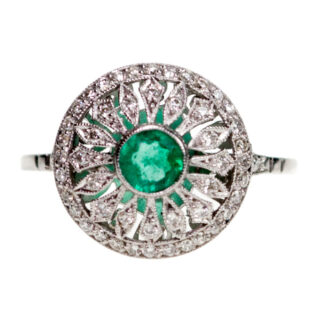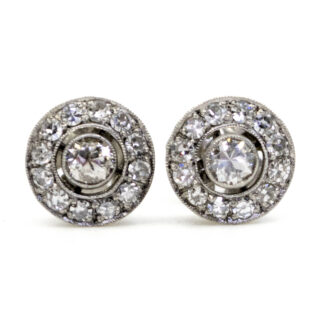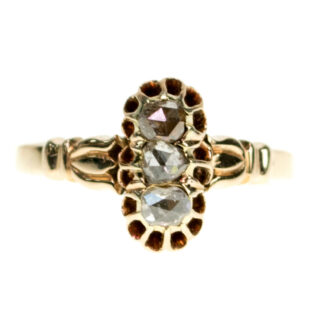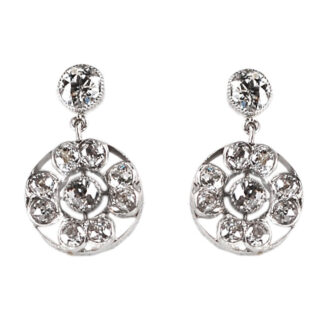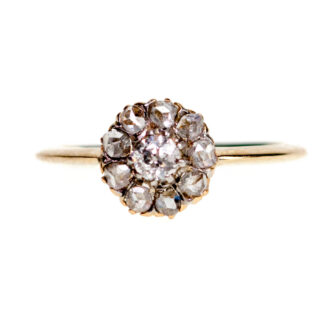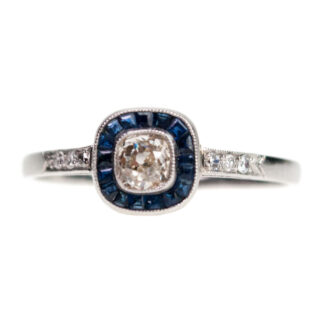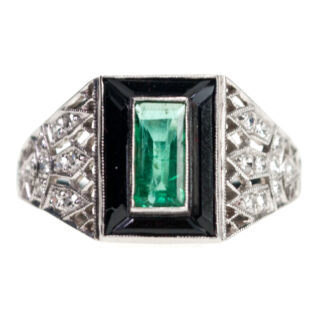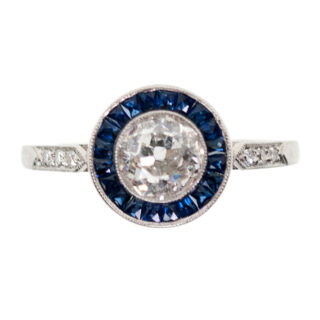Treat yourself to a timeless piece of décor with the classic Emerald & Diamond Rectangle-Shape Ring. This marvelous mid 20th century (1950-1970) rectangle-shape ring features a gorgeous 3.15ct emerald as the centerpiece, elegantly adorned with 0.25ct of baguette-cut diamonds. All set in luxurious platinum.
Details: ±3.15ct Emerald, ±0.25ct (I S1) Baguette-cut diamonds, Platinum Ring *.
Design Era: Binenbaum Vintage Revivals.
Size: 17.32 NL / 54.4 FR / 7 US / N½ UK.
Dimensions: H 0.6 x L 1.5 x W 1 cm.
Weight in grams: 4,5.
Condition: Very good condition – slightly used with small signs of wear.
Shipping and Pickup: This marvelous piece ships from our store located in the center of Amsterdam, The Netherlands. We offer both registered shipping and local pickup at our store. In the case of local pickup, any applicable shipping costs will be refunded.
About Us: Add some sparkle to your style with Binenbaum.com. We offer a stunning selection of antique and vintage jewelry that you won’t find anywhere else. From timeless rings and dazzling necklaces to unique brooches, we have something for every taste and occasion. Visit our website today and treat yourself to a piece of history.
| Design Era | |
|---|---|
| Design & Historical Context | At Binenbaum, our 40-year legacy, dating back to the early '80s, is more than just selling jewelry; it's about crafting timeless pieces that blend history with modern quality. Introducing our latest creation: Binenbaum Vintage Revivals. This unique collection draws inspiration from historic eras like Art Deco and Victorian to create contemporary designs that resonate with timeless elegance. But what truly sets Binenbaum Vintage Revivals apart is our commitment to sustainable luxury. We don't just mimic vintage styles; we revitalize and repurpose antique jewelry, ensuring each piece is both enduring and exquisite. In doing so, we infuse our personal touch into every creation, making each item a tribute to the rich history of jewelry and a story yet to be told. |
| Key Materials | |
| Materials & Craftsmanship | Emerald Emeralds are a variety of the mineral beryl, and their green color is due to the presence of chromium and sometimes vanadium impurities in the crystal structure. The best emeralds are highly transparent and have a rich, velvety green color. The color of an emerald can range from pale green to deep, rich green, and is often described as being similar to the color of grass or leaves. Emeralds have long been prized for their beauty and have been used in jewelry and other decorative objects for centuries. They are often cut into a variety of shapes, including oval, cushion, and pear, and are sometimes set in gold or platinum to enhance their beauty. Emeralds are also often treated to improve their color and clarity, and these treatments should be disclosed to the buyer. In terms of hardness, emeralds rank between 7.5 and 8 on the Mohs scale, making them relatively soft compared to other precious gemstones such as diamonds, which rank a 10 on the Mohs scale. This means that emeralds can be more prone to scratching and chipping, and should be handled with care. In addition to being used in jewelry, emeralds are also used in some traditional medical systems for their supposed healing properties. They are believed to have the ability to calm the mind and emotions, and to promote balance and harmony. Overall, emeralds are a highly prized and sought-after gemstone due to their stunning green color and the symbolism and symbolism associated with them. Baguette-cut diamond The baguette diamond cut is a rectangular-shaped diamond cut that belongs to the group of step cuts. Step cuts, such as the baguette cut, are characterized by their parallel facets that are arranged in a terrace-like pattern. These facets are typically longer and narrower than those found on other diamond cuts, such as round or princess cuts. Baguette-cut diamonds typically have 14 facets, which are the flat faces or surfaces on a diamond that reflect light. These facets are arranged in a specific pattern to enhance the diamond's sparkle and brilliance. Baguette-cut diamonds are usually smaller in carat weight than other diamond cuts, as they tend to be cut into narrow, elongated shapes. Baguette-cut diamonds are often used as side stones in engagement rings, or as accents in other types of jewelry. They are known for their clean, modern lines and their ability to add a touch of elegance to any piece. Overall, the baguette diamond cut is a popular choice for those who prefer a more rectangular shape and a sleek, minimalist look. Platinum Platinum is a white metallic element that is known for its strength, durability, and resistance to tarnish and corrosion. It belongs to a group of elements called the platinum group metals, which also includes osmium, iridium, palladium, rhodium, and ruthenium. Platinum is often found in nature as an alloy, which is a mixture of two or more elements. It can be mixed with other platinum group metals or with other elements such as copper, nickel, or cobalt. It wasn't until 1804 that all of the elements in the platinum group were isolated and named, with the exception of osmium, which was not isolated until 1841. Platinum is a highly prized metal that is often used in the manufacture of fine jewelry. It is malleable, meaning that it can be easily molded and shaped, and it is ductile, meaning that it can be drawn into thin wires or sheets. It is also very strong, which makes it suitable for use in a wide range of applications. Platinum is named after the Spanish word "platina," which means "little silver." It is thought to have been named this because of its white metallic luster, which is similar to that of silver. Platinum was first discovered by the Spanish conquistadors in South America, near the Pinto River in present-day Columbia. |
| Size | |
| Dimensions | H 0.6 x L 1.5 x W 1 cm |
| Gender | |
| Weight (in grams) | 4,5 |
| Condition | Very good condition – slightly used with small signs of wear |
Enhance the Beauty of Your Jewelry with Proper Care
Wearing your jewelry is a special way to express yourself and add a touch of personal style to any look. However, to ensure your jewelry remains in pristine condition, there are a few simple steps you need to take to keep it looking its best.
General Care Instructions:
Remove jewelry when showering or bathing, especially when at the beach, in the sea or in chlorinated water.
Avoid wearing jewelry while doing physical work such as housekeeping, gardening or exercise.
Storing your jewelry in a dry and cool place will help protect it from moisture, dirt and dust.
Keeping it away from harsh chemicals such as bleach, ammonia and chlorine will help to avoid discoloration and damage.
Cleaning your jewelry regularly with a soft cloth will help to keep it looking shiny and new.
Avoid exposing your jewelry to extreme temperatures, such as leaving it in direct sunlight or near a heater, as this can cause damage.
Handle your jewelry carefully and avoid dropping it, as this can cause the stones to loosen or the metals to scratch.
Finally, if possible, have your jewelry professionally checked and serviced. This will ensure that any potential problems are spotted and fixed before they become worse.
By following these tips, you can enjoy your precious jewelry for many years to come.
Related products
-
Emerald Diamond Platinum Cluster Ring 6903-4869
€ 2.995,00 VAT incl. (where applicable) -
Diamond Platinum Cluster Earrings 4977-4675
€ 3.395,00 VAT incl. (where applicable) -
Diamond 14k Vertical Trilogy Ring 8259-1984
€ 1.395,00 VAT incl. (where applicable) -
Diamond Platinum Pendant Earrings 5846-0616
€ 3.595,00 VAT incl. (where applicable) -
Diamond 14k Cluster Ring 6898-1835
€ 1.395,00 VAT incl. (where applicable) -
Diamond Sapphire Platinum Target Ring 6988-0010
€ 2.295,00 VAT incl. (where applicable) -
Diamond Emerald Onyx Platinum Deco Ring 7339-4900
€ 3.895,00 VAT incl. (where applicable) -
Diamond Sapphire Platinum Target Ring 6961-4858
€ 3.995,00 VAT incl. (where applicable)
- Home
- Collection
- Fine Jewelry
- Silver Jewelry
- Silverware
- Boxes
- Candlesticks
- Salt and pepper shakers
- Miniatures
- Salt cellars
- Spoon Set
- Condiments
- Frames
- Napkin Ring
- Spoon
- Oddities
- Cups
- Vases
- Cutlery
- Serving Spoon And Cake Server
- Candlesticks
- Baskets
- Hanukkiah
- Spice Tower
- Yad
- Tea Set
- Sugar Castor
- Napkin Rings
- Wine Bottle Coaster
- Wine Stopper
- Tea Pot
- Jugs
- Rattles
- Hip Flask
- Miscellaneous
- Rings 💍
- About
- Contact





